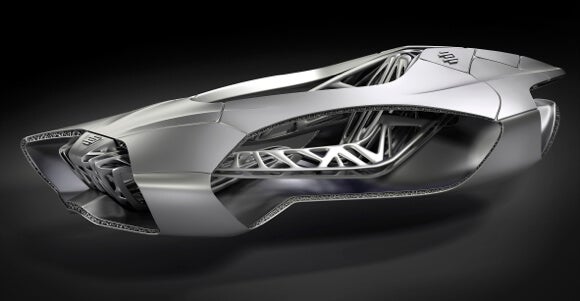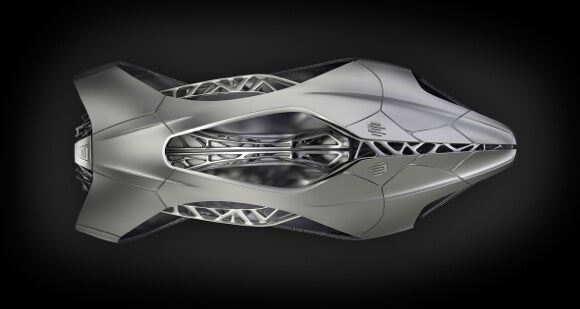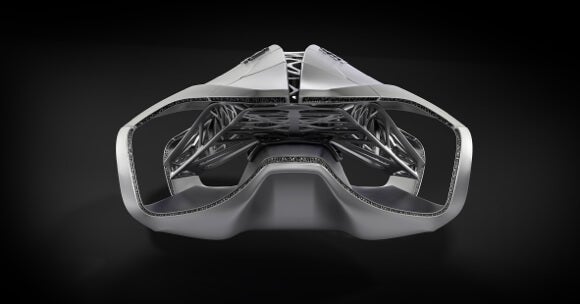German auto firm, EDAG, made a stir at this year’s Geneva Motor Show with a fully 3D printed auto body called Genesis. And why not? Its smooth grey curves and futuristic honeycomb ooze sex appeal. And did we mention 3D printed cars?
EDAG aids major carmakers in design and production, and they’re no stranger to the 11-day Geneva Motor Show, a mecca where over 600,000 car enthusiasts come to ogle the best cars of today and glimpse a few visions of tomorrow.
3D printing, of course, falls squarely into the second category. EDAG thinks additive manufacturing has the power to improve the entire carmaking process from design to production—and Genesis is meant to embody that potential.
However, although it demonstrates tech that may really have practical uses in car manufacturing, EDAG’s 3D printed body (Genesis) should be viewed with a touch of caution. The press release carefully disclaims that “there is still a long way to go before this becomes an industrial application, so for the time being, it remains a vision.”
And to be clear, EDAG haven’t figured out how to 3D print a car. This is a concept in the truest sense. EDAG’s concepts, like all good concepts, capture the imagination but aren’t necessarily practical or producible in the near future.
Prior EDAG creations include 2004’s supercar with built-in bed and suitcases for the hip, mobile multi-millionaire set. The car has yet to hit showrooms. Again, not remotely practical but plenty of fun. Nothing wrong with that.
All that said, Genesis is beautiful, artistic, flowing—and it really does fire the imagination. The design was inspired by a turtle’s skeleton. The shell’s intricate bone structures, EDAG says, provide protection, cushioning, strength, and stability. These finely tuned organic structures cannot be manufactured using traditional techniques.
Genesis is printed in one piece using fused deposition modeling (FDM). (FDM is the additive method most associate with 3D printing.) The printer accurately deposits just the right amount of material in the just the right spots to maximize strength and minimize weight. And the process is automated—an engineer inputs the design, hits start, and gets to work on something else as the printer spits out the body.
Though Genesis is conceptual, EDAG put plenty of thought into the technology behind it.
They note there are a number of shortcomings with current 3D printing, like build size and materials limitations. 3D printed plastics, for example, aren’t up to snuff when it comes to stiffness and strength. They chose FDM because there are no size restrictions and carbon fiber can be added to the printing process to make strong, light materials.
EDAG expects additive processes and associated automation technologies to bump productivity 100 to 1000 times in the next couple decades. And here’s a key insight sometimes lost in the shuffle of 3D printing proselytizing—EDAG thinks 3D printing will be worked into existing modes of car production where it makes sense.
In the Genesis press release they say, “Combinations of hybrid structures with classical construction methods (sheet metal, cast metal, fibre composites, etc.) will bring about radical improvements in functional properties and efficiency.”
Of course, EDAG aren’t alone in their 3D dreaming.
Jim Kor’s Urbee 2 would be a mostly 3D printed light vehicle. The Urbee isn’t printed in one piece, but it radically reduces the number of pieces needed for assembly. The dashboard for example, comes complete with ducts in place—eliminating the need for joints and connectors. Fewer parts means more efficient, faster assembly lines.
Though the Urbee team has struggled to finish the project, a recent influx of enthusiasm and continued support from sponsor, Stratasys, may yet make it happen.
And others are incorporating 3D printing in smaller ways.
High-end automaker, Koenigsegg, offers a car (the Koenigsegg One:1 hypercar) with a 3D printed turbo charger and exhaust tip. The exhaust tip is the largest piece of 3D printed titanium in the world (grain of salt) and takes three days to complete. Not exactly an efficient process, but for an exacting hypercar where cost is no barrier—perfect.
Altogether, 3D printing is most practical (and actually really useful) in rapid prototyping. That’s nothing new. But the technology is bleeding into real manufacturing processes too. And all the excitement, experimentation, conceptualizing, printer improvements, and added materials may yet bring the tech mainstream.
Image Credit: EDAG






